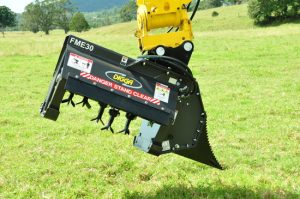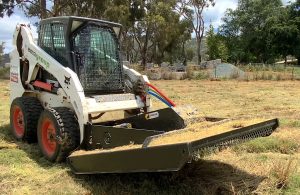
Flail mowers and slashers may share similarities, but these tools fulfil different functions and shouldn’t be confused with each other. Buying the wrong tool for the job can cost you time, fuel and money. Below, you’ll find our guide to understanding the difference between these two tools, in addition to some quick tips on whether to choose a flail mower or slasher.
What is a Slasher Mower?
A slasher can tackle a large expanse of overgrown grass very quickly and won’t stutter under the threat of hidden rocks and other debris. Due to their suitability for large swathes of tall, thick grass, they’re ideal for tidying up paddocks. And, with some fine-tuning, they can tackle grass of various lengths. However, if you use a slasher, you’ll end up with windrows and a less visually appealing overall finish due to this mower’s swing back blades.
What is a Flail Mower?
A flail mower combines the benefits of a slasher and a finishing mower. That is, they can tackle overgrown grass while still producing an attractive finish. Flail mowers do not produce windrows; instead, they output mulch that will rot back into the ground, nourishing the remaining grass and soil. This also benefits your soil by reducing the occurrence of pests and subsequently leads to less need for pesticides or herbicides.
Flail Mower vs Slasher: How to choose

While a flail mower might seem like the obvious choice based on the capabilities of both tools, your decision ultimately comes down to a number of factors.
- Will your tractor, skid steer or excavator support the flail mower and slasher?
If your tractor, skid steer or excavator isn’t capable of operating the slasher or flail mower, then there’s no point in considering other factors. Ultimately, this will come down to the horsepower of your machine’s engine.
Smaller machines with around 25 hp or lower will typically be limited to implements with a width no greater than 4 feet. For larger machines with up to 50 hp, you can increase your search to implements between around 4 and 6 feet. The largest tractors, excavators and skid steers with an engine of 50 to 80 hp, can support bigger implements of up to 7 feet.
-
How big is the task you need to tackle?
As we’ve discussed, slashers are best suited to larger tasks where the main consideration is clearing a paddock or other expanse of grass. If tidiness isn’t an issue, then a slasher could get the job done faster and cheaper.
However, if you need to prepare the land for another purpose, such as planting and growing crops, then you might be better off with a flail mower. The same applies if you’re clearing land that contains small saplings or other prunings that can be mulched alongside the grass cuttings.
-
Decide on your preferred finish
No slasher and flail mower will produce the same finish to your cut grass. While a slasher can get through overgrown grass more quickly than a flail mower, it will also leave windrows on your grass, which will need to be taken care of later once they have dried out.
However, a flail mower produces an attractive, even finish and has the benefit of encouraging new grass growth due to the mulching factor. While the process is more time-consuming, it produces a far better end result if aesthetics are important.
-
Decide how much ongoing maintenance you’ll tolerate
Your typical slasher comprises little more than a couple of swing back blades and a gearbox. You’ll need to ensure that the oil is topped up and that the blades are sharpened and kept free from debris. Otherwise, there’s very little else in the way of maintenance.
On the other hand, flail mowers require more expensive and time-consuming ongoing maintenance. Aside from the gearbox, you’ll also have to maintain belts, bearings and numerous other blades. Like slashers, you’ll need to monitor your oil level, but you’ve also got other tasks to take care of, including adjusting the belts as necessary, replacing blades when appropriate and greasing your bearings.
-
Determine your budget
While we’ve saved your budget until last, it’s by no means a small consideration. You’ll have to balance your preference for the above points against how much you’re willing to spend.
Slashers are less expensive than flail mowers, and since they require less maintenance, a slasher will cost you less in the long run. However, as you’ll have gathered, they’re more limited in what they can do and the results that you can expect to achieve.
While flail mowers are more expensive and require more costly maintenance, they can produce a more aesthetically pleasing end result. As a rough guide, you can expect to pay twice as much for a flail mower when compared to a slasher, though this comes down to the brand, size and quality of the mowers you’re comparing.
Summary
In summary, two of the most important points to consider when deciding on a slasher or flail mower are the horsepower of your machine and the finish you want to achieve. If clearing a paddock or other large expanse of grass is your main concern, then a slasher could be the right tool for the job. However, if you want an aesthetically pleasing finish and the benefits of mulching your grass into the soil, then a flail mower is better suited. Just be sure to check what implements your tractor, excavator or skid steer can support.

